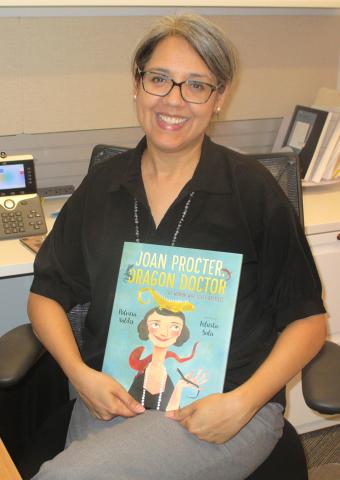The Lizard Lady
NIH’er Writes Children’s Book About a Herpetologist

Kids love a good dragon tale. One recently published children’s book, written by NIH’s Dr. Patricia Valdez, is a true story of real dragons and the kind, clever, fearless heroine who took care of them.
The book’s muse was Murphy, the Komodo dragon that Valdez and her family have long enjoyed visiting at the National Zoo. Her curiosity about Komodo dragons, the world’s largest lizards, ultimately led Valdez to write Joan Procter, Dragon Doctor: The Woman Who Loved Reptiles, published in 2018.
Valdez, an OER research integrity officer, started writing stories for her children Mateo and Maya, now 12 and 14, when they were little.
“I used to come home and tell them stories about my work,” said Valdez, who previously worked as a staff scientist in an NIAID lab. “I’d write little stories about the bad guy germs being defeated by our immune system.”
Six years ago, Valdez started writing stories about women scientists. One who piqued her interest was a British scientist named Joan Procter—the first female curator at the London Zoo’s Reptile House—whose name Valdez once stumbled upon while reading about Komodo dragons.
It’s particularly impressive to Valdez that Procter, the story’s herpetologist heroine, made her mark a century ago. She was the first person to describe Komodo dragons in captivity back in the 1920s, not long after they were first discovered.
“To have someone working with Komodo dragons [back then] was unusual,” said Valdez, “and to have a woman scientist was unusual as well.”
Valdez’s colorful picture book recounts how news spread of a fierce dragon coming to the zoo from the Indonesian island of Komodo. “It was rumored to be…30 feet long! Faster than a motorcar! Stronger than an ox!” Procter was intrigued, unafraid and excited to meet the mysterious creature.
Procter had always been enchanted by reptiles and amphibians. As a young girl, she studied them and kept lizards, snakes, and even a baby crocodile as pets. As a young scientist, she published papers about pit vipers and pancake tortoises. As an artist, she created models and drawings for reptile exhibits at London’s Natural History Museum. She later designed the Reptile House at the London Zoo, bringing in heated rocks, plants and other special features to mimic the animals’ natural habitats.

Photo: Dana Talesnik
When the two Komodo dragons arrived at the zoo in 1927, the first in all of Europe, Procter cared for and befriended them. She had a special bond with one in particular, named Sumbawa.
“Joan thought Sumbawa was brave; the keepers thought Joan was brave,” wrote Valdez. Procter gave many adults and children a closer look at Komodo dragons and dispelled the myths. They grew to be 8-10 feet in length, were not nearly as fast as a car and were usually gentle creatures.
Procter became an international sensation in her time, though faded into obscurity as the years went by. Valdez found a trove of information about her at Cambridge University’s Girton College, where Procter’s sister had worked. She bequeathed an archival gold mine of family stories, articles, photos and Joan’s artwork.
From the collection, “I got a good sense of her personality,” said Valdez. “She was pretty funny and a no-nonsense kind of person.”
Procter never went to college and had missed a lot of school due to a chronic illness. She got her professional start thanks to Dr. George Boulenger, a curator at the Natural History Museum, who recognized her potential and hired her as his assistant.
“One of the important things in science is for women to have a mentor,” said Valdez. “Showing that interaction and relationship [illuminates] how mentors can be advocates for women and minorities.”
Valdez hopes her book will inspire children, especially girls, who traditionally have been underrepresented in science fields, to become future scientists.
“I love how this cover shows Joan Procter as womanly,” said Valdez. “She’s got her pearls and yet she has these reptiles, [illustrating] that you can be feminine and be a scientist.”
Valdez has written a second children’s book, currently in production, that highlights a living female scientist involved in the discovery of gravitational waves.
“I think kids are fascinated by space and the new things we’re discovering,” she said.
Writing children’s books has become an important outlet for Valdez. As an NIH research integrity officer, she often deals with unpleasant topics such as allegations of research misconduct and undisclosed foreign influence. Having this positive hobby is a nice escape, she said, and she relishes being part of the author community.
Kids of all ages, even grown-ups, are likely to enjoy Joan Procter, Dragon Doctor, learn a lot and appreciate the vibrant illustrations.
Valdez is grateful for the illustrator’s whimsical style. “That’s kind of what I was feeling when I wrote the story and I think they got it just right.”
